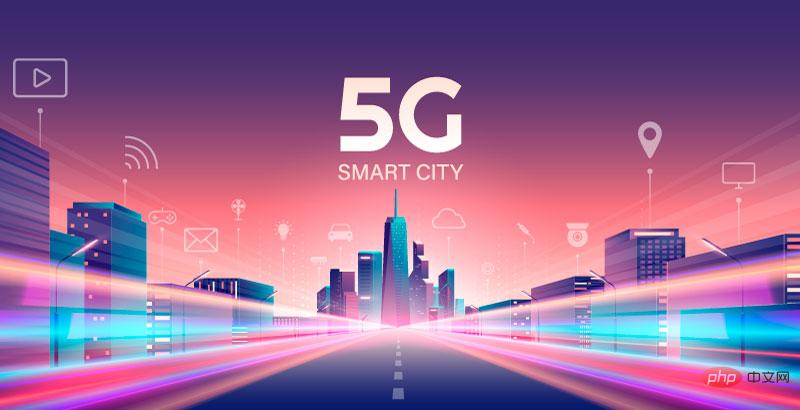Home >Common Problem >Mobile Internet and what are the main driving forces for 5g development
Mobile Internet and what are the main driving forces for 5g development
- 青灯夜游Original
- 2022-08-26 15:02:295449browse
The operating environment of this tutorial: windows7 system, Dell G3 computer.
Hu Jianbo, deputy chairman of the Information and Communications Development Strategy and Policy Committee of the China Communications Society and chief engineer of the China Academy of Information and Communications Technology, gave a speech titled "Globally Unified 5G Empowering the Digital Economy".
Hu Jianbo said that Mobile Internet and the Internet of Things are the two major driving forces of 5G. The combination of 5G with the power grid, transportation, and industrial technology will have a huge impact. "While 5G has brought about great changes, it has also spawned new technologies and new network architectures. Demand and new information technology will promote 5G's new service-oriented network architecture, using technologies such as network slicing and edge computing to meet different scenarios and industries. The demand."

The 5G era is an era of interconnection of everything, and the Internet of Things and the mobile Internet are its two major driving forces.
5G (fifth generation mobile communication technology) is a new generation of broadband mobile communication technology with high speed, low latency and large connection characteristics. 5G communication facilities are the network foundation for realizing the interconnection of humans, machines and things. facility.
As a new type of mobile communication network, 5G not only solves the problem of communication between people, but also provides users with more immersive and ultimate business experiences such as augmented reality, virtual reality, and ultra-high-definition (3D) video. It is necessary to solve the communication problems between people and things, and between things and things, and meet the needs of IoT applications such as mobile medical care, Internet of Vehicles, smart homes, industrial control, and environmental monitoring. Eventually, 5G will penetrate into all industries and fields of the economy and society, becoming a key new infrastructure that supports the digital, networked, and intelligent transformation of the economy and society.

Key Technology
5G Wireless Key Technology
5G international technical standards focus on meeting the needs of flexible and diverse Internet of Things. Based on the basic technologies of OFDMA and MIMO, 5G adopts a flexible new system design to support three major application scenarios. In terms of frequency bands, unlike 4G that supports mid- and low-frequency, 5G supports both mid-low and high-frequency bands, considering that mid- and low-frequency resources are limited. The mid-low frequency meets the coverage and capacity requirements, and the high frequency meets the need to increase capacity in hot spots. 5G is targeted at A unified technical solution is designed for mid-low frequency and high frequency, and supports a basic bandwidth of 100 MHz. In order to support high-speed transmission and better coverage, 5G uses LDPC, Polar's new channel coding scheme, and large-scale antenna technology with stronger performance. In order to support low latency and high reliability, 5G uses technologies such as short frames, fast feedback, and multi-layer/multi-station data retransmission.
5G network key technologies
5G adopts a new service-oriented architecture to support flexible deployment and differentiated business scenarios. 5G adopts a full-service design, modular network functions, and supports on-demand invocation to realize function reconstruction. It adopts service-oriented description to easily realize the opening of capabilities, which is conducive to introducing IT development strength and unleashing the potential of the network. 5G supports flexible deployment. Based on NFV/SDN, it realizes the decoupling of hardware and software and the separation of control and forwarding. It adopts the cloud networking of general data center, with flexible network function deployment and efficient resource scheduling. It supports edge computing and cloud computing platform. Sink to the edge of the network to support flexible selection of application-based gateways and edge offloading. Meet the differentiated needs of 5G through network slicing. Network slicing refers to selecting specific features and functions from a network and customizing a logically independent network. It allows operators to deploy multiple networks with different functions and feature services. Logical networks serve their respective target users. Currently, three types of network slicing are defined, namely enhanced mobile broadband, low latency and high reliability, and large-connection Internet of Things.
Expand knowledge:
Comparison between 5G and 4G
Compared with 4G, 5G is not simply about improving Internet speed. Instead, it comprehensively considers multiple technical indicators: network speed, mobility, latency, connection density, etc.
What does it mean? Network speed is easy for everyone to understand, so let’s talk about the meaning of several other indicators.
Mobility: refers to the ability to maintain transmission quality during rapid movement. For example, high-speed rail can now reach a maximum operating speed of 350 kilometers per hour, and will continue to increase in the future. 5G mobility must not only solve the problem of not disconnecting from the Internet when watching high-definition movies on the high-speed train, but also consider supporting a mobile speed of 500 companies per hour.
Latency: refers to the time difference from one end to the other end when transmitting data. 5G can provide latency as low as 1 millisecond, which is one thousandth of a second, which is 1/10 of 4G. It can fully meet the needs of industries such as Internet of Vehicles, industrial control, and telemedicine.
Connection density: refers to the number of various terminal devices that can be connected in the same area, while also meeting low cost and low power consumption requirements. This is mainly for Internet of Things and smart city applications. Therefore, 5G must not only pay attention to people's needs for network interconnection, but also promote the interconnection of all things including various sensing devices and vehicles.
The popularization and continuous upgrading of 5G will greatly expand the application scope of mobile communications and make our production and life more beautiful and convenient.

How fast is it to download a high-definition movie with 5G
We know that the current ordinary home broadband network can download a high-definition movie, such as " Harry Potter and the Philosopher's Stone" usually takes more than ten minutes. Even at the fastest speed claimed by the telecommunications company, it takes 2 minutes to download successfully. What if you use 4G network? The fastest download speed also takes 4 minutes. But in the 5G era, it only takes 2 seconds to download the same movie. It can really be said to be downloaded successfully in the blink of an eye.
The reason 5G is so fast is because it uses higher frequency radio waves. The higher the frequency, the greater the bandwidth that can be used and the greater the amount of data transmitted. For example, if 4G is a four-lane ordinary highway, 5G is a 40-lane three-dimensional highway, and its transmission speed can reach dozens of times that of the former.
If we are careful, we will find an interesting phenomenon: the previous "Big Brother" had very long antennas, and even early mobile phones had small protruding antennas. Why do current mobile phones have no antennas? In fact, it is not that the mobile phone does not have an antenna, but that it is stuffed into the mobile phone. The reason why 5G is fast is also related to this problem: the higher the frequency of radio waves, the shorter the antenna that needs to send and receive radio waves. The antennas of the 5G network are so short that they can be measured in millimeters. Therefore, many antennas can be placed in one device to form directional beams, and many sets of signals can be sent and received at the same time. The speed is of course much faster.
For more related knowledge, please visit the FAQ column!
The above is the detailed content of Mobile Internet and what are the main driving forces for 5g development. For more information, please follow other related articles on the PHP Chinese website!
Related articles
See more- What is the Internet of Things and how to understand the Internet of Things
- What is the name of the device that supports the interconnection of LAN and WAN?
- Why does a company use an intranet?
- Using html language to write web pages, what are the tags to implement hyperlinks?
- What are the devices that implement interconnection at the data link layer of computer networks?
- What is the e-commerce model for transactions between individual users using the Internet?
- What does network bridge mode mean?

